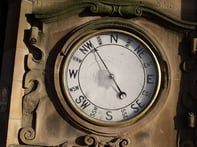Published on
The Profit Prophet: Clayton Christensen and the Future of American Higher Education

“In fifteen years from now, half of US universities may be in bankruptcy.”
So said Professor Clayton Christensen of Harvard Business School in 2013.
Well, perhaps so. Along the same lines one could say with equal insight and accuracy, “Next year the Chicago Cubs may win the National League pennant.” Or perhaps they may not.
The predictive power of social and behavioral sciences remains tantalizing but imperfect. And Clayton Christensen stands out as the latest in a long line of forecasters. Since his base is at Harvard Business School I think of him as the Profit Prophet.
The peculiar spell that professors such as Clayton Christensen cast on their audience is that the alchemy of PowerPoints, charts and graphs are mistaken as a gospel for deciphering the future of academic institutions. Christensen transformed a secular lectern into a bully pulpit at Harvard Business School.
A bittersweet side to Christensen’s higher education forecasts is that his major work on how and why industrial companies and business corporations succeed and fail was losing scholarly credibility about the time he shifted his analysis to colleges and universities.
Don’t just take my word for it. Evan R. Goldstein, editor of The Chronicle Review, surveyed the situation in the October 15, 2015 issue published as part of The Chronicle of Higher Education. Goldstein’s research and interviews showed that among Christensen’s strongest critics of the “creative disruption” theory have been some prominent professors at Harvard. One dean referred to him as the latest example of “Harvard Business School snake oil.” Even some Harvard Business School professors have taken Christensen to task about his use and abuse of data. Outside the business school but still inside Harvard Yard, Professor Jill LePore of the history department wrote an article for The New Yorker that dampened scholarly enthusiasm for Christensen’s dramatic theories of organizational behavior in which he invoked “disruptive theory.”
Despite these critical concerns, Christensen has gained a significant following for his views on higher education. Presidents and provosts listen to him at national conferences—and, perhaps even read his works. Here was “The Answer!” They implored their trustees and administrative lieutenants to heed Christensen’s inspired, albeit unfounded, insights about change and the “DNA of higher education.” Unfortunately, it was an example of a case where a professor turned out to be comparable to the Wizard of Oz. Exposed to critical analysis, his projections appeared to be a humbug.
Consider Christensen’s 2011 book on higher education, The Innovative University, co-authored with Henry J. Eyring. Its generalizations are grounded in case studies of two institutions—Harvard University and Brigham Young University-Idaho. I guess those two institutions are reasonable choices, but they are not accidental. Christensen writes about the institution where he did his graduate work and then joined the faculty—Harvard. His co-author, who serves as an adjunct fellow at The Clayton Christensen Institute for Disruptive Innovation, is the Academic Vice President of BYU-Idaho. The co-authors purport to ground their analyses in history, but it’s history lite. They are neither historians nor economists.
What’s sad about the lure Christensen’s works had for about a decade was that higher education leaders—presidents, deans and trustees—had great books by seasoned scholars such as economists Howard Bowen, William Bowen, Ronald Ehrenberg, Michael McPherson, Charles Clotfelter, Robert Archibald and David Feldman available at their disposal. If you want to know how Harvard works, I recommend you read historians Morton Keller and Phyllis Keller’s Making Harvard Modern: The Rise of America’s University or Henry Rosovsky’s The University: An Owner’s Manual. I also rely on the incredibly original historical research by Bruce Kimball and Benjamin Johnson on how over the past century Harvard’s presidents and boards shaped the university’s fundraising, investments and endowments.
One of my favorite books for insights about higher education as an enterprise and organization is Robert Birnbaum’s 2000 work, Management Fads in Higher Education. Birnbaum, who has served and excelled as a university president and academic administrator as well as a professor and prolific scholar, acts as a tour guide through the relics and ruins of numerous “solutions” borrowed from business and industry and applied to higher education. He tells us “where they came from, what they do, and why they fail.” As with any memorable book, a reader goes away satisfied with the story and argument, yet still hungry for more.
Clayton Christensen has provided ample data for a revised, expanded volume in 2016 as a new chapter for Birnbaum to bring his own book up to date on higher education fads—at least for now!
Author Perspective: Analyst



